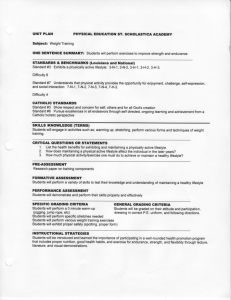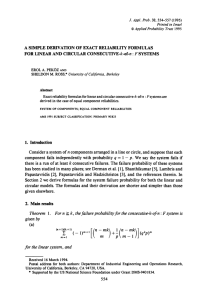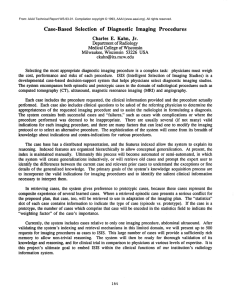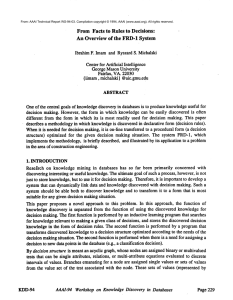Strategic Evaluation in Complex Domains
advertisement
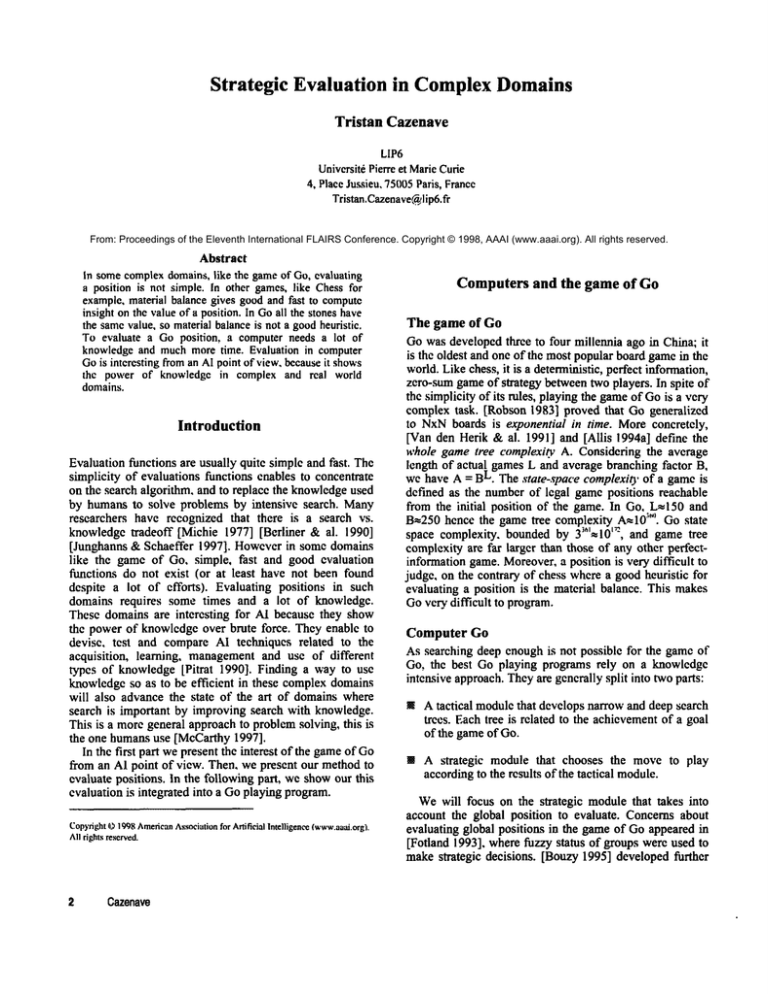
Strategic Evaluation in ComplexDomains Tristan Cazenave LIP6 Universit6Pierre et MarieCurie 4, Place Jussieu, 75005Paris, France Tristan.Cazenave@lip6.fr From: Proceedings of the Eleventh International FLAIRS Conference. Copyright © 1998, AAAI (www.aaai.org). All rights reserved. Abstract In somecomplexdomains,like the gameof Go, evaluating a position is not simple. In other games,like Chessfor example,material balance gives goodand fast to compute insight on the valueof a position. In Goall the stoneshave the samevalue, so materialbalanceis not a goodheuristic. To evaluate a Go position, a computer needs a lot of knowledgeand muchmore time. Evaluation in computer Gois interesting froman AI point of view,becauseit shows the power of knowledge in complex and real world domains. Introduction Evaluation functions are usually quite simple and fast. The simplicity of evaluations functions enables to concentrate on the search algorithm, and to replace the knowledgeused by humans to solve problems by intensive search. Many researchers have recognized that there is a search vs. knowledgetradeoff [Michie 1977] [Berliner & al. 1990] [Junghanns & Schaeffer 1997]. However in some domains like the game of Go, simple, fast and good evaluation functions do not exist (or at least have not been found despite a lot of efforts). Evaluating positions in such domains requires some times and a lot of knowledge. These domains are interesting for AI because they show the power of knowledgeover brute force. They enable to devise, test and compare AI techniques related to the acquisition, learning, managementand use of different types of knowledge [Pitrat 1990]. Finding a way to use knowledgeso as to be efficient in these complex domains will also advance the state of the art of domains where search is important by improving search with knowledge. This is a more general approach to problemsolving, this is the one humansuse [McCarthy 1997]. In the first part we present the interest of the gameof Go from an Al point of view. Then, we presem our method to evaluate positions. In the following part, we showour this evaluation is integrated into a Goplaying program. Copyright t~) 1998Americ:mAssociation for Artificial Intelligence (www.aaai.org). All fights reserved. 2 Cazenave Computers and the game of Go The game of Go Go was developed three to four millennia ago in China; it is the oldest and one of the most popular board gamein the world. Like chess, it is a deterministic, perfect information, zero-sumgameof strategy betweentwo players. In spite of the simplicity of its rules, playing the gameof Gois a very complex task. [Robson 1983] proved that Go generalized to NxNboards is exponential in time. More concretely, [Van den Herik & al. 1991] and [Allis 1994a] define the whole game tree complexi.tv A. Considering the average length of actual games L and average branching factor B, we have A = BL. The state-space complexiO, of a game is defined as the numberof legal game positions reachable from the initial position of the game. In Go, L~lS0 and B~250hence the game tree complexity A=10~"~. Go state ~’-2", and game tree space complexity, bounded by 33~%10 complexity are fax larger than those of any other perfectinformation game.Moreover,a position is very difficult to judge, on the contrary of chess where a good heuristic for evaluating a position is the material balance. This makes Govery difficult to program. Computer Go As searching deep enough is not possible for the game of Go, the best Go playing programs rely on a knowledge intensive approach.Theyare generally split into two parts: H A tactical modulethat develops narrow and deep search aces. Each tree is related to the achievementof a goal of the gameof (3o. ! A strategic module that chooses the move to play accordingto the results of the tactical module. Wewill focus on the strategic modulethat takes into account the global position to evaluate. Concerns about evaluating global positions in the gameof Goappeared in [Fotland 1993], where fuzzy status of groups were used to makestrategic decisions. [Bouzy 1995] developed further the strategic part involved in Go programs and managed relations between groups with fuzzy status. [Cazenave & Moneret1997] gives a methodto develop strategic plans in situations involving uncertainty. Evaluating a position Strategic knowledgein gamesis about long term goals. In games such as Chess and Go, the high numberof possible movesmakesit impossible to forecast in the long term the consequences of the moves played. A solution to this problem is to have a gradual achievement of long term goals, it enables to knowif a movemakes the goal easier or harder to achieve. There are mainly two ways of managing a complex situation, breaking the problem into subproblems and relax the problem by def’ming a gradual achievementof it. ¯ "lW I Figure 1 This is particularly true for the strategy in the gameof Go. The ultimate goal of a player is to makelive the morestone on the board. However, in the middle game, most of the groups of stones (a group of stones is a set of stones of the same color which cannot be disconnected, stones of the same group have the same number in Figure 1) are in an uncertain state, and the evolution of this state cannot be precisely foreseen. It is very useful in such a case to have a gradual evaluation of their states and of the evolution of this state whenplaying different moves. A friend intersections of a group is an emptyintersection that can be connected to the group whatever the opponent plays, moreover, this empty intersection must not be connectable to a living opponentgroup. Figure 2 In Figure 2, the white friend intersections are filled with a small white point. The black friend intersections are filled with a small black point. The intersections thatcan be connected both to a white and a black group are filled with a small gray point. Each group owns a set of friend intersections of its owncolor. The numberof friend intersections of a group is a very goodheuristic to approximatethe degree of life of a group. For example, the group marked with 2 in Figure 2 has morethan twelve friend intersections, it will therefore have no problems to live. Whereasthe group marked with 3 in Figure 2 has only 7 friend intersections, it is not completely alive and mayhave some problems. Its degree of life is around0.5. Tworules defmethe degree of life of a group given its numberof friend intersections: Degree_oflife ( N, G, F ) Numberof friend_intersections ( N, G, H ), H>3, FI= (H-3)/9, F =min(FI, 1.0). Degree_of__life( N, G, F ) Numberof friend intersections ( N, G, H ), H<4, F =0.0. After these rules have been fired, one nile chooses the greatest of all the degreesof life. The gradual degree of life is given by the real numberF, the group is represented by the variable G, and the integer N is the numberof movesto play to achieve this degree of life. The Figure 3 gives the graphical representation of the gradual achievementdefined by the rules above. 0 ! 2 3 4 5 6 7 8 9 101112 Number of friendintersections Figure 3 Manypredicates contributes to the final goal of the AIApplications 3 game: having more living stones than the opponent. These contributions are more or less graduals. They are represented in Figure 4. The vertical axis alwaysrepresents the degree of life of the group, between0 and I. rl 0 I [/ 2 0 2 3 Number of unsetth.xi life bases Numbcrof wonlife bases 0 I 1 2 i 0 0.5 0.33 0.16 0 0 0.5 2 0 0 0 0 1 0 3 4 0 0 0 0 0 0 0 0 0.44 0.8 0 9 1 1 0.44 1 Thestrategic evaluationfunctionin a Go playing program P 3 Attributes\Groups Numberof wonlife bases Numberof unsettled life bases Numberof won eyes Numberof unsettled eyes Numberof friend intersections Numberof connections to living friends Degreeof life of the group Table 3 Numberof ~m ~Vcs AND/OR Tree Search 0 I 2 3 Number of connectionsto living friends 0 I 2 3 4 5 6 Numberof untitled eyes Figure 4 Table 2 gives an evaluation of the attributes for the tbur groups of Figure 1. Attributes’,,Groups Numberof won life bases Numberofunsetded life bases Numberof won eyes Numberof unsettled eyes Numberof friend intersections Numberof stones Numberof connections to living friends Table 2 I 0 l l l 3 5 0 2 0 0 0 0 26 7 0 3 0 0 0 0 7 3 0 4 0 0 0 0 I1 I 2 Table 3 gives the degrees of life corresponding to each attribute for each group and also gives the final degree of life for the groups. Our Go playing program is named Gogol. It develops AND’OR tree searches to calculate the states of tactical games. Each tactical gamecorresponds to a simple subgoal of the gameof Go. The tactical gamesstatus are used to create the groups and to fill the predicates used by the strategic module. Gogol develops approximately 1000 proof tree searches on a position. It develops trees using Proof NumberSearch [Allis & al. 1994b], the result of a tree is a tactical theoremthat applies to the boardat hand: the movesadvised by the theoremalways reach the tactical goal used during the search. These proof trees contain between 2 and 600 nodes. Once the tactical results are deduced, the programfires the strategic evaluation rules that evaluate the degree of life of each group and its evolution after each interesting move.This information is used to choose the best move.The best moveis chosen by evaluating the difference of the board value after and before each move. The best moveis the movethat has the highest difference. To evaluate the value of the board, the system has to evaluate the degree of life and the importance of each group. The importance of a group is the evaluation of the difference of points at the end of the gamebetweenthe life of the group and its death. It is computed using the tbllowing rule: Value( G, N ) Numberof stone ( G, N! ), Number_of_friend_intersections( G, N2 ), Number_of__shared._friend_interseetions ( G, N3), N=NI +NI +N2 +N3. Groups Value of the group 4 Cazenave Whenthe values and the degrees of life of the groups have been computed,the system can evaluate a Go board: Evaluation = (Degree~* Value)5". (Degree, * Value) j Results with i E Friends Groups and j E OpponentGroups. I"I If the board is evaluated after the two black moves,there is a variation of +12 points for the black moveat i28 and a variation of +11 points for the black move at i59. The system will choose the black moveat i28. I Figure 6 In the exampleof Figure 2, if black is the friend color, the evaluation of the position gives: Evaluation=0.5*23+0.44*32-1.0*80-1.0*31 =-85.4 This evaluation meansthat black is probably going to lose the gameby 43 points. This analysis is compatible with the analysis of Goexpert players. This evaluation function has been tested on numerous Go boards and it gives a good approximationof the evaluation of a position. The two moveswe are examining in the board of Figure 6 are the black movesat i28 and i59. Table 4 gives the outcomes of the black moveat i28 and Table 5 gives the outcomesof the black moveat i59. Attributes\Groups Numberof wonlife bases Numberof unsettled life bases Numberof won eyes Numberof unsettled eyes Numberof friend imersections Numberof connections to living friends Table 4 1 +1 -1 +1 -1 0 0 2 0 0 0 0 0 0 3 0 0 0 0 0 0 4 0 0 0 0 0 0 Attributes\Groups Numberof wonlife bases Numberof unsettled life bases Numberof won eyes Numberof unsettled eyes Numberof friend intersections Numberof connections to living friends Table 5 1 0 0 0 0 0 0 2 0 0 0 0 -4 0 3 0 0 0 +1 0 0 4 0 0 0 0 -1 -1 The best Go programs are those that have the best strategic evaluation function and the most precise tactical search engines. But it takes times to evaluate position, because for each strategic position evaluation, a lot of tactical searches have to be performed. So Go programs cannot search very deep at the strategic level. The precision of the evaluation function is therefore very important. It is based on a goodknowledgeof what are the important concepts of the game of Go (such as territory, influence, groupsand their degrees of life). Gogol plays a move in 10 seconds on a Pentium 133 MHz.It has participated in the 1997 FOSTcup held during IJCAI97.It has finished 6 out of 40 participants. The five first programsare commercialprograms. Future work is to use learning, as described in [Cazeuave 1996], at the strategic level. The goal of learning will be to improvethe evaluation of positions and to find strategic movesinteresting to try. Conclusion Evaluation in computerGo is interesting from an AI point of view, because it shows the power of knowledge in complex and real world domains. In the search versus knowledgetradeoff, the gameof Gois the one that has the most important knowledge component. Wehave shown how a complex evaluation function can be devised by breaking the problem into suhprohlem, and relaxing the goals by making them gradual. This approach has been used to write the evaluation function of a Go playing program. It has shownits usefulness during the last FOST cup [Fofland 1997], an international competition between Go programs. References Allis, L.V. 1994a. Searching for Solutions in Gamesand Artificial Intelligence, Ph.D. Thesis, Vrije Universitat Amsterdam,Maastricht, September 1994. Allis, L.V.; Meulen, M. van. der; Herik, H.J. van den 1994b. Proof-NumberSearch. Artificial Intelligence, Vol. 66, No. 1, pp. 91-124. Bediner, H.; Goetsch, G.; Campbell, M.; Ebeling, C. 1990. Measuring the performance of potential chess programs. Artificial Intelligence, 43(1) :7-21, April 1990. AIApplications § Bouzy, B. 1995. Moddlisation cognitive du joueur de Go. Th~sede l’universit6 Paris 6, 1995. Cazenave, T. 1996. b~’stbme d’Apprentissage par AutoObservation. Application au Jeu de Go. These de l’Universite Paris 6, D6cembre1996. Cazenave, T.; Moneret, R. 1997. Development and Evaluation of Strategic Plans. Game Programming Workshop’97, Hakone, Japan 1997. Fotland, D. 1993. KnowledgeRepresentation in The Many Faces of Go. Second Cannes/Sophia-Antipolis Go Research Day, F6vfier 1993. Fotland, D.; Yoshikawa, A. 1997. The 3rdfost-cup worldopen computer-go championship. ICCA Journal 20 (4):276-278. Junghanns, A.; Schaeffer, J. 1997. Search Versus Knowledgein Game-Playing Programs Revisited. IJCAI97 p. 692-697, Nagoya, Japan, 1997. McCarthy, J. 1997. Review of Mon~. , Newborn~ Kasparov versus Deep Blue : ComputerChess Comesof Age. SciEnce ,6 June 1997. Michie, D. 1977. A theor), of advice. MachineIntelligence 8, p. 151-170,1977. Pitrat, J. 1990. M~taconnaissances.Futur de l’lntelligence Artificielle. Editions Hermes,Paris, 1990. Robson, J. M. 1983. The Complexity of Go - Proceedings IFIP - pp. 413-417- 1983. Vanden Herik, H. J.’- Allis, L. V.; Herschberg,1. S. 1991. Which Games Will Survive ? Heuristic Programming in Artificial Intelligence 2, the Second ComputerOlympiad (eds. D. N. L. Levy and D. F. BeaD, pp. 232-243. Ellis Horwood. ISBN0-13-382615-5. 1991. 6 Cazenave


